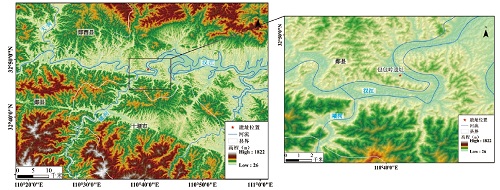

A preliminary report of the 2021 excavation at the Baobaoling site in Yunyang, Hubei
Received date: 2023-11-18
Revised date: 2024-01-29
Online published: 2024-10-10
Baobaoling site is a lower Paleolithic open-air site located on the third terrace of the left bank of the Han River in Zhengjiahe Village, Qingqu Town, Yunyang District, Shiyan City. From July to November 2021, the Hubei Provincial Institute of Cultural Relics and Archaeology, together with the Shiyan Museum and Yunyang Museum, excavated the site with an area of 196 square meters and unearthed 341 pieces of lithic artifacts of different types. The types of lithic artifacts include cores, flakes, scrapers, choppers, points, handaxes, etc., with the most common being flake fragments, debris, chunks, and manuports, followed by flakes and cores, and the number of tools was small, mainly consisting of large and medium-sized cobble tools. The main raw materials of the lithic artifacts were vein quartz, followed by siliceous rock, and other rocks such as gabbro, sandstone, and andesite also accounted for a certain proportion. There are two retouched systems for the tools: one is the Chaîne Opératoire of small flake tools made from vein quartz, and the other is the Chaîne Opératoire of large cobble tools such as handaxes and choppers made from siliceous rock, gabbro, etc., and the two systems are independent of each other. Through the analysis of raw material exploitation and utilization strategies of the lithic artifacts from the site, it can be observed that ancient humans during this period had a clear understanding of different types of stones. They developed different utilization strategies based on the characteristics of different stone materials, enabling them to create both large and small tools using stones of different properties. Neither prepared behavior of the platforms and the flaked surfaces were observed on the cores and flakes. The selection of platforms generally had no special retouchings, with most being cortexs, while some were joint and plain platforms. Three debitage techniques, including hammering, bipolar knapping, and anvil technique, were observed, and there may also be the Yangtze flaking technique. Most of the cores had few flaking sequences, a small number of removals, simple flaking surfaces, and had not yet formed a fixed mode. The dating results showed that the site was at least 300,000 years old. There are few sites and locations in the Han River Basin’s third terrace that have been continuously dated by stratigraphic dating, and there is no more specific and in-depth research on the formation age of different strata. The discovery of Baobaoling Site provides important materials for exploring the cultural and technical capabilities and adaptive survival characteristics of ancient humans in the upstream area of the Han River during the Middle Pleistocene, and provides reliable references for the study of other sites in this region.

Key words: Han River Basin; Baobaoling Site; Lithic artifacts; Lower Paleolithic
GAO Huangwen , LIU Yingjie , LU Chengqiu , SUN Xuefeng , HUANG Xuchu , XU Jingyue . A preliminary report of the 2021 excavation at the Baobaoling site in Yunyang, Hubei[J]. Acta Anthropologica Sinica, 2024 , 43(05) : 828 -838 . DOI: 10.16359/j.1000-3193/AAS.2024.0009
| [1] | 沈玉昌. 汉水河谷的地貌及其发育史[J]. 地理学报, 1956, 23(4): 296-323 |
| [2] | 李天元, 王正华, 李文森, 等. 湖北省郧县曲远河口化石地点调查与试掘[J]. 江汉考古, 1991, 2: 1-14 |
| [3] | 李英华, 孙雪峰. 湖北郧县后房旧石器遗址发掘简报[J]. 江汉考古, 2013, 1: 6-15 |
| [4] | 王社江, 孙雪峰, 鹿化煜, 等. 汉水上游汉中盆地新发现的旧石器及其年代[J]. 人类学学报, 2014, 33(2): 125-136 |
| [5] | 周振宇, 王春雪, 高星. 丹江口北泰山庙旧石器遗址发掘简报[J]. 人类学学报, 2009, 28(3): 246-261 |
| [6] | 李浩, 李超荣. 丹江口库区大土包子旧石器遗址发掘简报[J]. 人类学学报, 2020, 39(3): 349-356 |
| [7] | Wintle AG, Murray AS. A review of quartz optically stimulated luminescence characteristics and their relevance in single-aliquot regeneration dating protocols[J]. Radiation Measurements, 2006, 41(4): 369-391 |
/
| 〈 |
|
〉 |